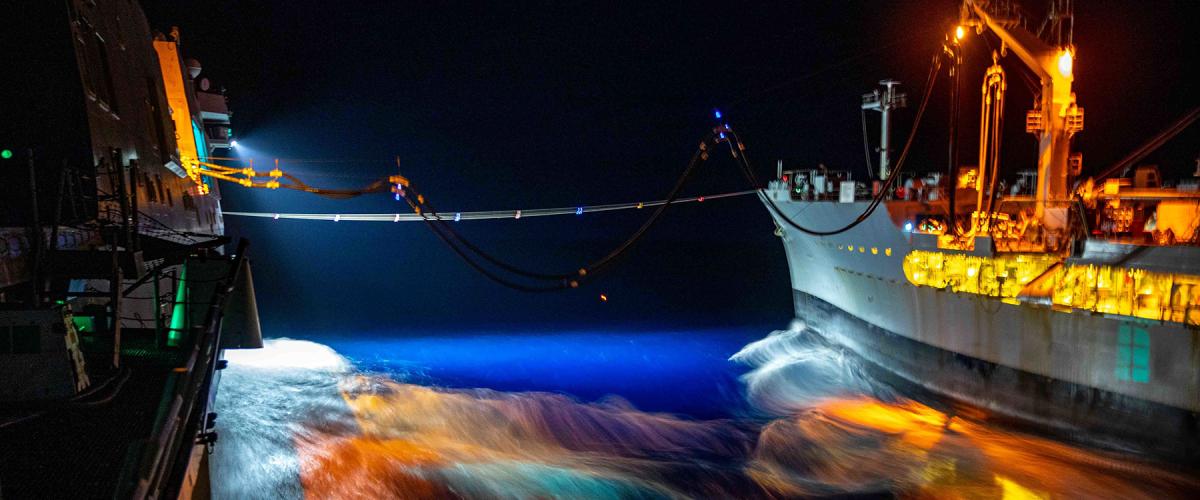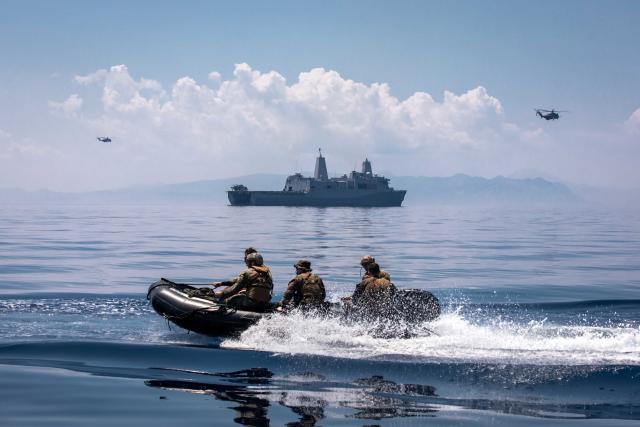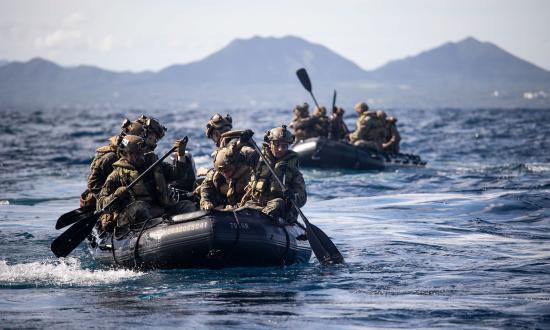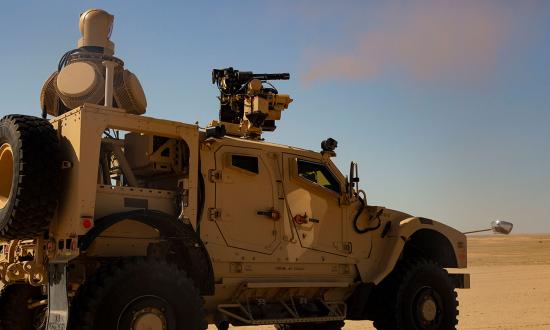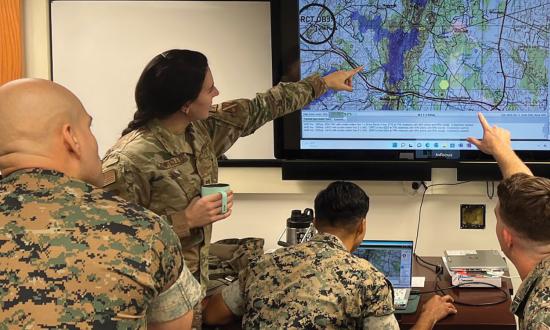Editor’s note: This is the third of three articles discussing the utility of the unclassified wargame in the development of force design efforts. To read the first article and cover the entirety of the context and methodology, click here. To read the second article, click here.
In May 2022, the authors conducted a series of unclassified exercises and wargames intended to explore the potential of two key elements of Force Design 2030: its concept for stand-in forces and the developing Marine littoral regiment (MLR). In cooperation with the Marine Corps Warfighting Lab, the School of Advanced Warfighting conducted Exercises Agile Competition and Agile Response and designed several wargames. We examined the possible roles of stand-in forces and the MLR in naval campaigning, both during competition and in conflict. Notably, the participants used only unclassified and publicly available materials to inform, develop, and execute these events.
The wargame’s focus was on sustainment requirements rather than considerations of the proper employment of forces. The participants developed a plausible friendly force posture and scheme of maneuver but did not focus on optimizing the Marine expeditionary unit’s (MEU’s) or MLR’s combat power relative to the enemy. Despite these limitations, the authors made several key findings that may be useful for future discourse surrounding Force Design 2030. In addition, this event highlights the wider utility of unclassified wargaming for the national security community. In discussing the methods used, we provide a replicable tool that can be used to analyze and synthesize force design efforts and can incorporate allies and partners who might otherwise be excluded from such events.
Sustainment Wargame
The specific objective of the sustainment wargame was to determine the cost-effectiveness of MLR deployments within the concept for stand-in forces employment. The wargame used the following scenario, methodology, starting conditions, and planning factors:
Scenario. MLR and amphibious ready group (ARG)/MEU formations were tasked to support joint sea-denial operations in the Luzon Strait to prevent People’s Liberation Army Navy (PLAN) surface combatants from passing the first island chain and establishing an effective blockade east of Taiwan. The scenario assumed a coalition effort in Taiwan, the Senkakus, and some Japanese islands to support the same purpose. The scenario also assumed access, basing, and overflight agreements with the Philippines.
Methodology. The method was designed to determine sustainment costs under four conditions: an MLR in competition, an MLR during conflict, a MEU in competition, and a MEU during conflict. Quantitative assessment included comparing the relative sustainment burdens for both deployed formations in light and heavy configurations. The operational planning team (OPT) executed a three-phased wargame.
Phase 1 used MLR and MEU composition to determine sustainment requirements during competition. To test these, players calculated projected daily consumption rates for an MLR and MEU of multiple classes of supply, including Class I (food and water), Class III (fuel), Class IV (construction materials), Class VI (personal demand items), and Class VIII (medical). Historic MEU deployments provided data against which to compare and validate these calculations. After confirming sustainment requirements for both formations, the OPT aligned sustainment platform capabilities to identify consumption rates unique to each formation to determine enduring sustainment requirements within competition.
Phase 2 used the joint combat simulator Command Professional Edition (PE) to simulate an operational-level sustainment event for both the MLR and MEU. This permitted the OPT to identify a quantified combat loss estimate, logistics expenditure assessment, and combat sustainment requirement for munitions, fuel, and replacement vehicles. The simulation included multiple Monte Carlo evolutions, a model used to forecast possible outcome probability when the intervention of random variables is present by simulating an event multiple times while accounting for variability in different factors. A generic joint combat escort operation enabled the logistics platform to conduct the operational sustainment.
Phase 3 involved the OPT combining the phase 1 and phase 2 results into an estimated cost to operate the MLR and MEU for a month during conflict.
Starting conditions. The MEU and MLR cases had similar starting positions, with the principal differences coming in the shipping (an ARG for the MEU versus a six light amphibious warships for the MLR), the absence (MEU) or presence (MLR) of large USVs, and the number of EABs (two for the MEU, three for the MLR.
Planning factors. The OPT used multiple references to support planning estimates, all of which were collected in an accompanying annex. The most significant planning factors for sustainment were logistics estimates using planning tools developed by the Marine Corps Logistics Operations Group (MCLOG), the Marine Corps’ institutional caretaker of the Logistics Tactics, Training, and Education Program.
Findings and Observations
The iterative simulations in Command PE, informed by the quantitative assessments of sustainment planning, revealed dozens of individual findings and observations. It should be emphasized that these findings are bound by the limitations of this wargame, and they are not meant to be conclusive. However, they provide valuable insights that can help shape future discussion of sustaining stand-in forces. Consider the following significant findings from the game:
In conflict, the MEU was more cost-effective to sustain than the MLR, based on enduring monthly requirements, combat loss estimate, and combat sustainment requirements. It cost $10,847,089,243 per month to sustain the MLR during conflict. Most of this figure represents the combat losses and munitions expended during the two joint resupply operations required by the MLR each month. In contrast, it cost $4,998,388,307 per month to sustain the MEU during conflict. A major distinction is that the increased lift available to the MEU reduced the sustainment interval to only once per month. The wargaming team observed that the MEU experiments sustained fewer combat losses thanks to the MEU’s F-35 detachment establishing local air superiority. This suggests that MLR combat losses could be similarly reduced by employing it in conjunction with F-35s.
Cost Imposition on the PLA. The MLR was marginally more combat effective than the MEU in terms of cost imposition on the PLA, on the order of 3 percent. This appears to have been due to the MLR’s organic air-defense assets and ability to tie into the larger joint/coalition air-defense picture. The coalition force that included the MLR imposed combat losses of approximately $3.73 billion on the PLA (largely in fighter/attack platforms, and diesel submarines) compared to approximately $3.599 billion in combat losses imposed on the PLA by the coalition force that included the MEU.
In competition, the MLR was more cost-effective to sustain than the MEU. Even though the MEU’s demand was smaller than the MLR’s—thanks to the latter’s deployment of smaller formations—the cost to sustain an MLR during conflict was less than that to sustain the MEU because of the cost associated with operating the amphibious shipping. Using the heavy MLR force package, which is based on the 3d MLR tables of organization and equipment, it cost $3,996,103 to sustain an MLR for a month during competition, while it cost $8,390,204 to sustain a MEU for the same time and under the same conditions. The long range and relatively low operational cost of notional light amphibious warships (LAWs) was the most significant cost saving during competition.
Navy fuel budgeting complicates LAW fuel cost forecasting. If LAWs are the primary mobility asset for the MLR and the primary logistics connector, then MLR commanders will expect to be able to direct the LAWs when and where they choose. However, Navy fuel budget planning links the number of fuel barrels needed in a specific year to each ship type. The barrel projection is fed from data collected in the Navy Energy Usage Reporting System. If this same process is applied to projecting LAW fuel requirements for the Navy, it potentially reduces the ability of the MLR commanders to control LAW employment because the Navy could restrict the ships’ operational hours.
Prestaging heavy and oversized parts greatly reduces ground maintenance costs. To establish a baseline for ground maintenance costs, the OPT reviewed after-action reports (AARs) from the 11th, 13th, 15th, and 26th MEUs. The AARs revealed an average maintenance cost of approximately $1 million for a six-month MEU deployment. To help reduce the cost of transporting parts not in the deployed Class IX block, the AARs from each MEU recommended prestaging heavy or oversized parts in theater, rather than shipping them via mail to reduce cost. Reducing the number of large parts in the Class IX block also provides the opportunity to reduce the cubic foot cost on the ship. Lastly, the AARs identified the need for similar units to deploy with a contracting officer possessing a warrant for at least $500,000. Units that deployed with contracting officers who had warrants for less than $500,000 could not support themselves during the deployment. This implies useful applications of contracting in support of the MLR.
Embarkation, debarkation, and travel costs remain hidden. The sources used to establish the cost-effectiveness of the MEU and MLR—tables of organization, tables of equipment, command briefs, planning factors, and wargaming software—did not enable the OPT to estimate the cost to embark and debark, such as the cost to use civilian ports and transportation. These sources also did not reveal the costs for travel, such as the hundreds of thousands of dollars often spent on travel orders during a single MEU deployment. This important data should be collected from Marine expeditionary force disbursing offices and used in future cost-projection planning.
Recommendations
Given the constraints and restraints of the method employed, the findings are suggestive but not conclusive regarding avenues for further exploration by those involved in planning for naval campaigning and force design. Still, the findings yield recommendations for future study of sustainment of the MLR.
Defining Cost. This wargame primarily developed cost estimates in the form of U.S. dollars. However, sustainment costs can be defined, considered, and communicated in other ways, some of which may be more useful than simple dollars. This could include time and space considerations regarding tonnage (for which the data is available within the wargame results), opportunity costs in terms of what forces dedicated to sustainment tasks cannot do instead, as well as the costs imposed on the adversary as a result of successful sustainment.
Future Study. The appendices developed during the wargame, which include an array of planning factors and Command PE data for developing sustainment options for the MLR, should be applied to future studies. The appendices are unclassified, and the Marine Corps Warfighting Lab could make them available to appropriate researchers and planners. One appendix provides a user-friendly Microsoft Excel interface to manipulate and modify data sets. Another provides detailed summaries of the executed wargames in Command PE. Command PE operators can access these appendices, download the XML files, and import those into the game to facilitate deeper analysis as well as future iterations of wargames similar to those executed during this exercise. This research supports planners in understanding a baseline of what is possible for employing the LAW, using the available specifications. If the specifications change, planners can modify the data to understand the impact of those modifications.
Staying Agile
Each of the three wargames developed for the Agile series resulted in important findings that suggest avenues of consideration for analysts and planners supporting Force Design 2030. They yielded recommendations for aligning the MLR with joint and coalition forces, employing the MLR to better support deterrence and assurance, and identifying sustainment planning factors at a level of detail heretofore unseen using open-source data.
More than that, these wargames reveal how useful unclassified sources can be in developing ways to analyze, test, and refine emerging concepts of force design and employment. In this transformative moment, analysts, scholars, and practitioners have much to offer, yet many feel as though the wall of classification separates them from an ability to have a lasting impact. In addition, classification hurdles often exclude the most important players in the stand-in forces concept—allies and partners. This need not be the case. Tabletop wargaming, modeling and simulation, and everything in between create room to meaningfully test and explore these ideas in the unclassified realm.
Note: The views expressed here are those of the authors and do not represent the positions or opinions of the Italian Army or any part of the government of Italy or the U.S. Department of Defense.
Additional authors: Lieutenant Colonel Thomas Quinn, British Royal Marines; Lieutenant Colonel Semming Rusten, Norwegian Army; Major Demetrio Riggio, Italian Army; Major Adam Bunker, U.S. Air Force; Major Tim Russell, U.S. Army; Majors Tyler Quinn, Andrew Wright, Eric Prentice, Paul Trower, Clark Smith, Ryan Hamilton, U.S. Marine Corps; Lieutenant Colonels Pete Combe and Brian Kerg, U.S. Marine Corps.



